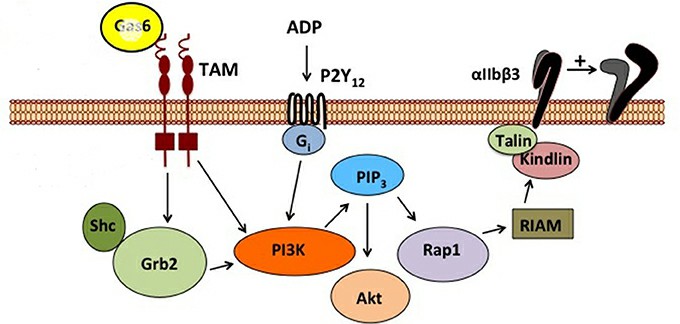What is GAS6 Protein
The GAS6 protein, a member of the vitamin K-dependent family, has emerged as a pivotal player in cellular processes, with a complex structure and multifunctional roles.
What is GAS6 Protein?
GAS6, an acronym for Growth Arrest-Specific 6, is a secreted protein encoded by the GAS6 gene located on chromosome 13. Structurally, GAS6 comprises an N-terminal γ-carboxyglutamic acid (Gla) domain, four epidermal growth factor (EGF)-like domains, and a C-terminal sex hormone-binding globulin (SHBG)-like domain. The Gla domain facilitates calcium-dependent interactions with phospholipid membranes, enabling GAS6 to associate with cell surfaces.
The Structure of GAS6 Protein
The intricate structure of GAS6 is a testament to its diverse functionalities. The N-terminal Gla domain, essential for membrane interactions, precedes the four EGF-like domains, which contribute to the protein's overall stability and function. The C-terminal SHBG-like domain further enhances the structural complexity of GAS6, emphasizing its role in intricate cellular processes.
The Function of GAS6 Protein
GAS6 orchestrates a range of physiological processes through its interaction with TAM receptors (Tyro3, Axl, and Mer). This interaction initiates downstream signaling cascades crucial for cellular functions:
- Cell Survival and Proliferation
By activating TAM receptors, GAS6 promotes cell survival and proliferation. This function is particularly vital in tissues characterized by high cell turnover, such as the immune system and reproductive organs.
- Immune Regulation
GAS6 exhibits immunomodulatory effects, influencing the activity of immune cells. It regulates the function of macrophages, dendritic cells, and natural killer cells, contributing to immune homeostasis.
- Phagocytosis
GAS6 facilitates the clearance of apoptotic cells by enhancing the phagocytic activity of macrophages. This function is critical for maintaining tissue integrity and preventing inflammation.
GAS6-Related Diseases
Dysregulation of GAS6 expression or signaling pathways is implicated in various pathological conditions, including cancer, autoimmune disorders, and neurological diseases:
- Cancer
Elevated GAS6 expression and TAM receptor activity are observed in numerous cancers. The GAS6/TAM axis promotes tumor cell survival, migration, and invasion, contributing to cancer progression.
- Autoimmune Disorders
Aberrant GAS6 signaling is linked to autoimmune diseases such as systemic lupus erythematosus (SLE) and rheumatoid arthritis, where it may modulate immune responses and contribute to tissue damage.
- Neurological Disorders
The GAS6/TAM system plays a role in neuroinflammation and neurodegenerative diseases. It influences microglial activation and phagocytosis in the central nervous system, impacting the progression of conditions like Alzheimer's disease.
GAS6 Related Signaling Pathways
The intricate signaling pathways activated by GAS6 involve complex molecular interactions, influencing various cellular responses:
- PI3K-Akt Pathway
Activation of the PI3K-Akt pathway is a common downstream effect of GAS6 binding to TAM receptors, promoting cell survival, growth, and metabolism.
- MAPK/ERK Pathway
GAS6 activates the MAPK/ERK pathway, contributing to cell proliferation and differentiation, crucial for maintaining tissue homeostasis.
- NF-κB Pathway
GAS6 can activate the NF-κB pathway, influencing immune responses and inflammation, offering insights into its role in various diseases.

Figure 1. Schematic representation of GAS6/TAM signaling pathway. (Law, L.A., et al. 2018)
Applications of GAS6 in Biomedical Research
The unique properties of GAS6 make it a promising candidate for diverse biomedical applications:
- Cancer Therapy
Targeting the GAS6/TAM axis in cancer cells is a burgeoning area of research. Inhibitors of TAM receptors or GAS6 blocking antibodies hold potential to impede tumor growth and metastasis.
- Neurodegenerative Diseases
Modulating GAS6 signaling is being explored for therapeutic interventions in neurodegenerative diseases. Insights into its role in neuroinflammation may pave the way for novel treatments for conditions like Alzheimer's and Parkinson's.
- Immunotherapy
The immunomodulatory effects of GAS6 present opportunities for developing novel immunotherapies. Harnessing its potential could revolutionize the treatment of autoimmune diseases.
- Regenerative Medicine
GAS6's role in cell survival and proliferation positions it as a promising candidate for regenerative medicine. Manipulating GAS6 signaling may enhance tissue repair and regeneration, opening avenues for innovative therapeutic strategies.
GAS6 protein, with its intricate structure and diverse functions, has become a focal point in molecular biology research. From its roles in cell survival and immune regulation to its implications in diseases and potential applications in biomedical fields, GAS6 continues to unveil its wonders, offering new avenues for understanding and manipulating cellular processes for therapeutic purposes.
Recommended Products for GAS6 Protein
| Cat.# | Species | Product name | Source (Host) | Tag |
|---|---|---|---|---|
| GAS6-613H | Human | Active Recombinant Human Growth Arrest-Specific 6, His-tagged | Mammalian cells | His |
| GAS6-288TH | Human | Recombinant Human GAS6 full-length, GST-tagged | Wheat Germ | GST |
| GAS6-3014H | Human | Recombinant Human GAS6 Protein, His (Fc)-Avi-tagged | HEK293 | His (Fc)-Avi |
| GAS6-382H | Human | Recombinant Human GAS6(Ala31-Ala678) Protein, C-Fc-tagged | HEK293 | Fc |
| GAS6-2540H | Human | Recombinant Human GAS6 Protein (Trp379-Ala678), N-His tagged | E.coli | N-His |
| Gas6-483M | Mouse | Active Recombinant Mouse Gas6, His-tagged | Mammalian cells | His |
| Gas6-196M | Mouse | Recombinant Mouse Gas6 Protein, His/GST-tagged | E.coli | His/GST |
| Gas6-197R | Rat | Recombinant Rat Gas6 Protein, His-tagged | E.coli | His |
| Gas6-1563R | Rat | Recombinant Rat Gas6 Protein, His&GST-tagged | E.coli | N-His&GST |
| GAS6-10341Z | Zebrafish | Recombinant Zebrafish GAS6 | Mammalian Cell | His |
Reference
- Law, L.A., et al. GAS6/TAM Pathway Signaling in Hemostasis and Thrombosis. Front Med (Lausanne). 2018, 5: 137.

